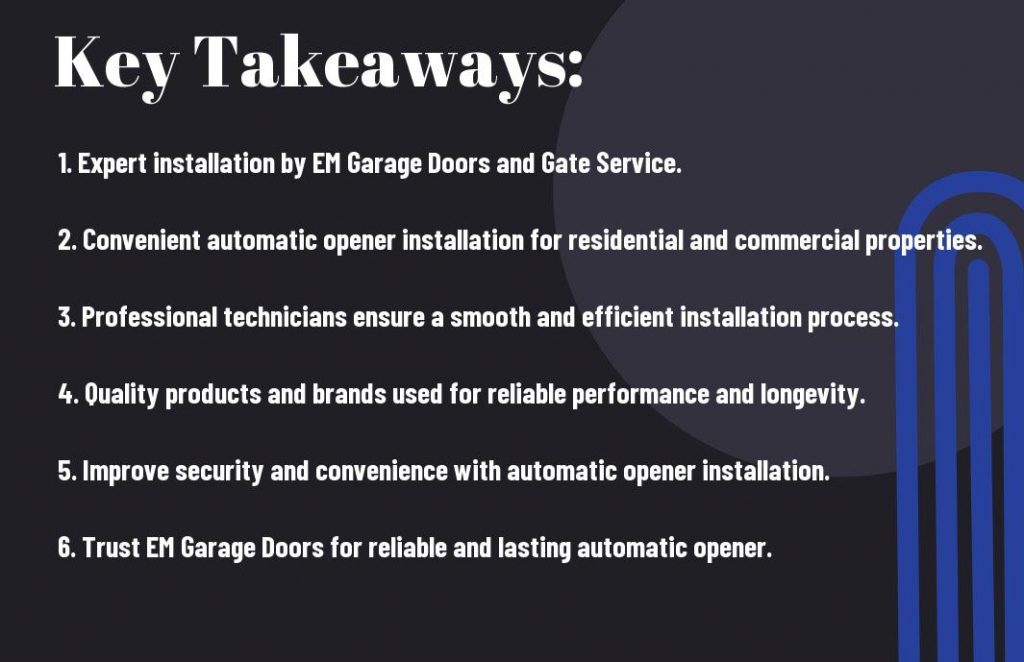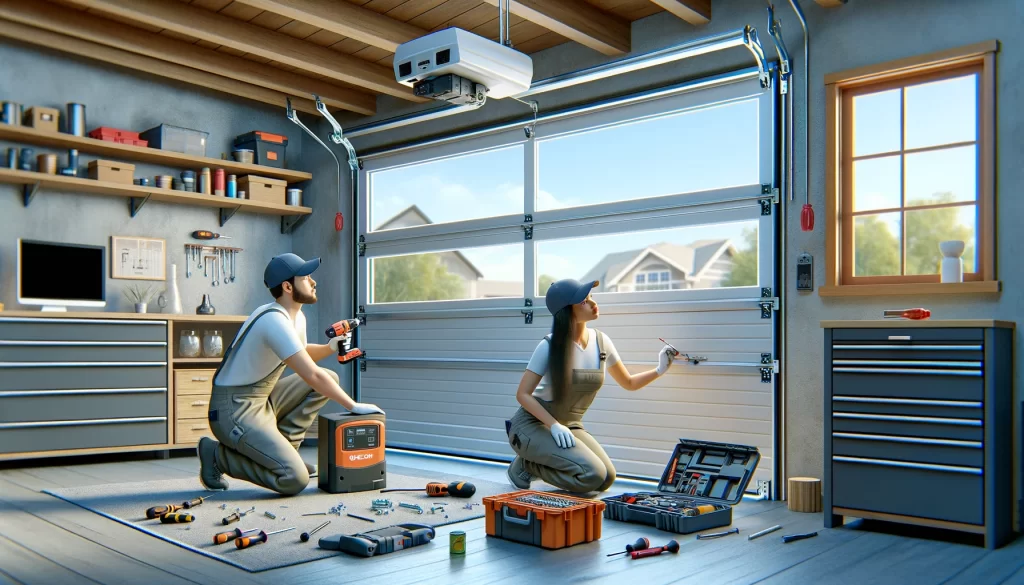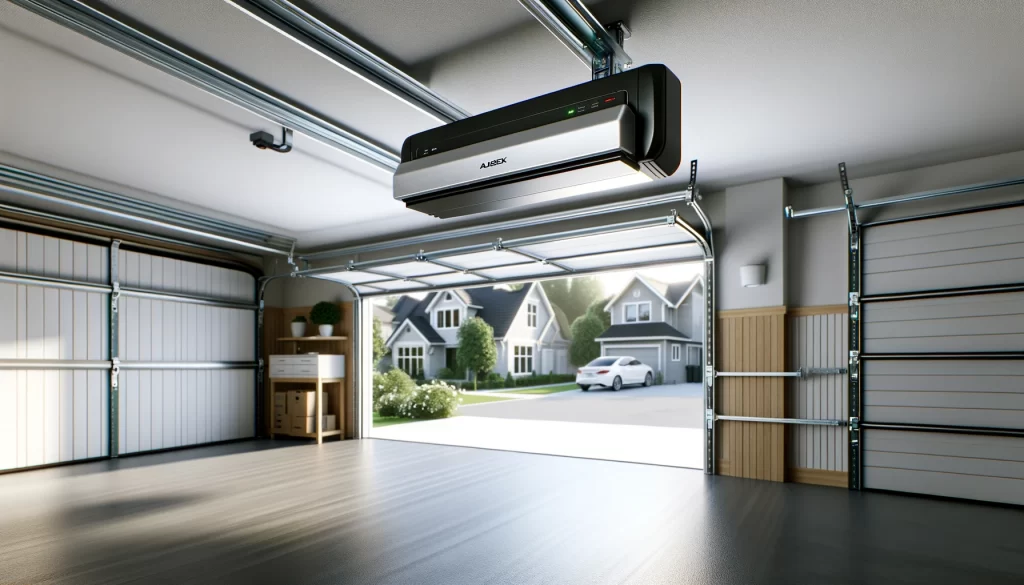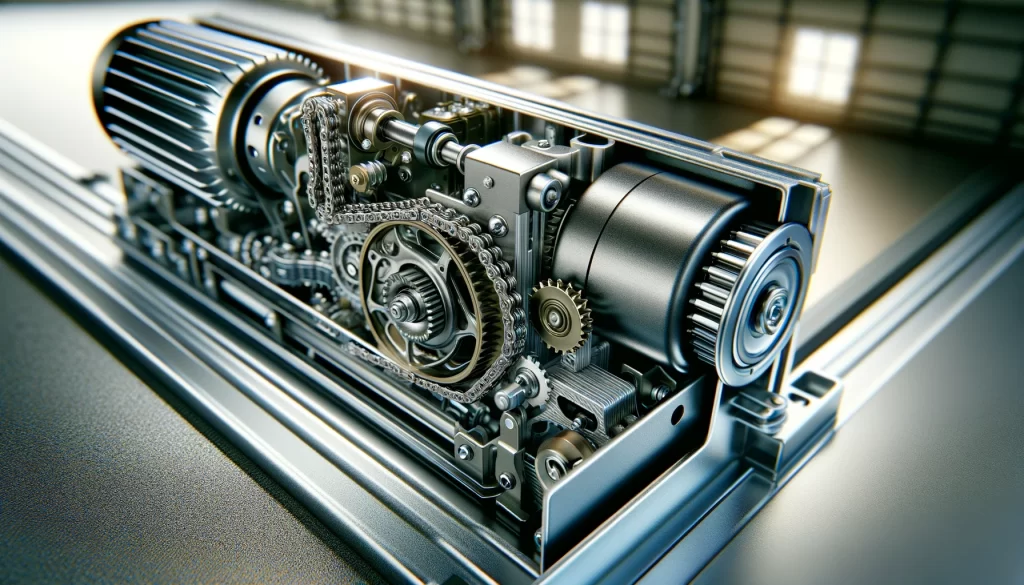Are you considering upgrading your garage door with an automatic opener for convenience and security? Look no further than EM Garage Doors and Gate Service for all your installation needs. Our team of experts will ensure a seamless and efficient installation process, providing you with reliable and safe operation for years to come. For automatic opener installation, it’s crucial to entrust the job to experienced professionals to avoid any potential hazards or malfunctions.
At EM Garage Doors and Gate Service, we have the technical expertise and industry knowledge to ensure that your automatic opener is installed with precision and attention to detail. You can trust us to deliver top-notch service, leaving you with peace of mind knowing that your garage door is in capable hands. Whether for residential or commercial properties, we have the solution for you.

Understanding Automatic Openers
Understanding how automatic openers work is essential to making the right choice for your garage door or gate. Automatic openers are like the heart of your system, providing the power and control needed for smooth and convenient operation.
Principle of Operation
Automatic openers use a motor to drive a trolley along a rail, which moves the door or gate. The motor is controlled by a remote or a switch, allowing you to open and close the door or gate quickly. The opener also includes safety features such as sensors that detect obstacles in the door’s path and prevent accidents.
Types of Automatic Openers
Several automatic openers are available, each suited for different garage door or gate setups. The most common types are chain-driven, belt-driven, and screw-driven openers. Chain-driven openers are the most affordable but can be noisy, while belt-driven openers are quieter but slightly more expensive. Screw-driven openers are known for their reliability and minimal maintenance requirements.
- Chain-driven opener: Affordable but noisy
- Belt-driven opener: Quieter but slightly more expensive
- Screw-driven opener: Reliable and low-maintenance
Though all three types of openers are reliable, it’s essential to consider factors such as noise level and maintenance requirements when choosing.

Selecting the Right Automatic Opener
Assuming you’ve decided to install an automatic opener for your garage door, the next step is to select the right one for your specific needs. This can be a daunting task, considering the wide range of options available in the market. However, with the proper guidance and information, you can make an informed decision that will suit your requirements perfectly.
Analyzing Garage Door Specifications
When selecting an automatic opener, analyzing your garage door specifications is crucial. You should consider the weight and size of your garage door and the type of drive system that will work best with it. For example, if you have a heavy wooden or steel door, you will need an opener with more power to operate smoothly and efficiently. Additionally, the type of door track and clearance space available in your garage will also impact your choice of automatic opener.
Considering Environmental Factors
When choosing an automatic opener, it’s essential to consider the environmental factors that your garage door will be exposed to. If your garage is in an area with extreme temperatures, such as very cold or hot climates, you must ensure the opener is designed to function correctly. Additionally, if your garage is prone to high levels of moisture or dust, you should opt for an opener designed to withstand these environmental factors. The durability and longevity of your automatic opener greatly depend on its ability to withstand the environmental conditions it will be exposed to.
- Extreme temperatures: If you live in an area with harsh weather conditions, you should look for an opener with insulated housing to protect it from extreme cold or heat.
- Moisture and dust resistance: Ensure that the opener you choose has adequate sealing and protection to prevent moisture and dust from affecting its performance.
A suitable automatic opener can significantly enhance the convenience and security of your garage, so it’s essential to carefully analyze your garage door specifications and consider the environmental factors that will impact its performance to select the most suitable one.
Steps in Automatic Opener Installation
Despite the technological advancements in automatic opener installation, the process can still be intricate and overwhelming for the average homeowner. However, with the proper guidance and expertise, you can successfully install an automatic opener for your garage door. This chapter will walk you through the essential steps in automatic opener installation, ensuring a smooth and efficient process.

Preparing for Installation
Before beginning the installation process, preparing your garage for the new automatic opener is crucial. This involves clearing out any obstructions and ensuring the door is properly working. Additionally, you will need to gather all the necessary tools and equipment, including a ladder, power drill, and the opener kit. It’s vital to thoroughly read through the installation manual and familiarize yourself with the different components of the opener.
Once you have prepared the space and gathered the required tools, you can begin the initial steps of installation. This includes assembling the opener and mounting the header bracket, which will support the motor of the automatic opener. It’s essential to follow the manufacturer’s instructions carefully and take time with this process to ensure proper alignment and support.
Actual Installation Process
The installation involves attaching the rail to the header bracket and connecting it to the power unit. You will need to install and connect the trolley to the garage door. This step requires precision and caution to ensure that the opener functions correctly and does not cause any damage to the door. Once the opener is securely in place, you can proceed with programming the remote control and testing the functionality of the automatic opener.
Throughout the installation process, it’s essential to prioritize safety and take necessary precautions to avoid accidents or mishaps. If you encounter any challenges or uncertainties during the installation, it’s advisable to seek professional assistance to avoid any potential risks. By following these steps and exercising diligence, you can successfully install an automatic opener for your garage door, enhancing the convenience and security of your home.
Ensuring Safety During Installation
Since you have decided to install an automatic opener for your garage door, ensuring the installation process is carried out safely is essential. At EM Garage Doors and Gate Service, we prioritize safety during every installation to protect our technicians and customers.
Safety Measures in Automatic Opener Installation
When installing an automatic opener, it is crucial to follow safety measures to prevent accidents and injuries. Before beginning the installation process, it’s essential to disconnect the power supply to the garage door to avoid any electrical mishaps. Additionally, please read the manufacturer’s instructions carefully and follow them. This will ensure that the opener is installed correctly and safely. Testing the opener’s safety features, such as the auto-reverse mechanism, is essential to ensure they function correctly before installation.
Handling Installation Equipment Safely
Handling installation equipment safely is another crucial aspect of ensuring safety during installation. When working with power tools and heavy equipment, wearing appropriate safety gear such as gloves, goggles, and closed-toe shoes is essential. Keep the work area clean and organized to prevent tripping hazards. Additionally, always use equipment as intended and avoid taking unnecessary risks. Remember, your safety is paramount during installation, so never compromise on safety measures. By following these safety measures and cautiously handling installation equipment, you can ensure a safe and successful automatic opener installation for your garage door. EM Garage Doors and Gate Service is committed to providing high-quality installations while prioritizing the safety of our customers and technicians.

Troubleshooting Automatic Opener Installation Issues
However, issues may arise with your automatic opener, even with professional installation. It’s essential to be able to troubleshoot and identify these problems to ensure your opener is functioning as it should.
Common Problems in Automatic Opener Installation
Some common problems with automatic opener installation include the opener not responding to the remote, the door not opening or closing entirely, or the opener making unusual noises during operation. These issues can be frustrating, but addressing them promptly is essential to avoid further damage to your garage door system.
Practical Solutions for Installation Issues
When faced with these common problems, there are a few practical solutions you can try. First, ensure that the batteries in your remote are not depleted and that the remote is within range of the opener. If your door is not opening or closing fully, you may need to adjust the open and close limits on the opener. Lastly, if you hear unusual noises from the opener, it may be a sign of worn or damaged components that need replacing. In any case, it’s best to contact a professional technician to diagnose and repair these issues to ensure the safety and longevity of your garage door system.
Maintaining Your Automatic Opener
Keeping up with regular maintenance is essential to ensure your automatic opener continues to function correctly. By taking the time to perform routine checks and maintenance, you can extend the lifespan of your automatic opener and prevent costly repairs down the line.
Preventive Maintenance Tips
One of the most important aspects of maintaining your automatic opener is to perform regular lubrication of the moving parts. This includes the hinges, rollers, and tracks. Keeping these components well-lubricated will help to prevent wear and tear and ensure smooth operation. Additionally, regularly testing your automatic opener’s safety features is essential. This includes the auto-reverse function, which should stop and reverse the door if it encounters an obstruction. You should also check the door’s balance by disconnecting the opener and manually lifting it to see if it opens and closes smoothly. Finally, keep the photo-eye sensors clean and aligned correctly to prevent any obstructions that could interfere with the door’s operation.
- Lubricate moving parts regularly.
- Test safety features such as auto-reverse function
- Check the balance of the door
- Keep photo-eye sensors clean and aligned
Knowing the signs of wear and tear and addressing them promptly is crucial to preventing significant issues with your automatic opener. Following these preventive maintenance tips, you can keep your automatic opener in top condition and avoid costly repairs.
Repair and Replacement Options
Despite your best efforts to maintain your automatic opener, there may come a time when repairs or replacements are necessary. If you notice any strange noises, jerky movements, or other signs of malfunction, it’s essential to address these issues promptly. Ignoring these signs can lead to further damage and costly repairs. Sometimes, a professional technician may recommend repair options such as replacing worn-out parts or realigning tracks. In more severe cases, a complete replacement of the automatic opener may be necessary to ensure the safety and functionality of your garage door.
Conclusion: Automatic Opener Installation by EM Garage Doors and Gate Service
Drawing together all the information we have provided, it is clear that installing an automatic opener for your garage door or gate is a wise investment. Not only does it provide convenience and security, but it also adds value to your property. EM Garage Doors and Gate Service delivers top-notch installation services that meet your needs and preferences. With our team of experienced professionals, you can trust that the job will be done efficiently and effectively, leaving you with a reliable automatic opener that will enhance the functionality of your garage or gate.
So why wait any longer? Contact EM Garage Doors and Gate Service today to schedule your automatic opener installation. You can trust that our team will provide you with the highest quality service, ensuring your garage or gate operates optimally for years. Take the first step towards enhancing the convenience and security of your property by entrusting your automatic opener installation to the experts at EM Garage Doors and Gate Service.
FAQ
Q: What types of automatic openers do EM Garage Doors and Gate Service install?
A: EM Garage Doors and Gate Service installs a variety of automatic openers, including chain drive, belt drive, and screw drive openers. We can recommend the best option for your specific needs and budget.
Q: Is professional installation necessary for automatic openers?
A: Professional installation is crucial for automatic openers to ensure proper functionality and safety. Our experienced technicians are trained to install automatic openers correctly, including programming and testing for smooth operation.
Q: How long does installing an EM Garage Doors and Gate Service automatic opener take?
A: The time it takes to install an automatic opener depends on the type of opener, the size of the garage or gate, and any additional features requested. However, our team works efficiently and strives to complete installations promptly without compromising quality.
Critical Facts About Automatic Opener Installation
- Tendency to Stretch Over Time: Extension springs on garage doors tend to stretch over time. This may necessitate removing the spring from the door and compressing the coils for accurate length measurement. The spring’s coil remains firm despite stretching, and its torque level typically does not require adjustment.
- Indicators for Replacement or Adjustment: If your garage door feels heavy, opens or closes unevenly, or doesn’t open, it might be time to replace or adjust the extension springs. Choosing the correct springs based on the door’s weight is crucial for effective functioning.
- Mechanism of Operation: Extension springs are designed to store energy by extending when the garage door is closed and releasing it when it is opened. They are mounted on either side of the door and connected to the garage door cables.
- Pre-adjustment Positioning: To adjust the springs, the door must be in a position that releases the tension on the springs, usually the up position. Clamping the door to prevent it from falling while making adjustmentsis essential.
- Safety Measures: Always wear protective gear like safety glasses, gloves, and sturdy footwear during the adjustment process—disconnect the power to the garage door opener to prevent accidental movement.
- Adjustment Techniques: Adjusting extension springs can be done by moving the hook that holds the cable to another hole or loosening the clamp on the cable and adjusting its length. Moving the hook one hole away from the door frame decreases tension, while moving it toward the frame increases it.
- Balancing and Gap Issues: If there is a gap along the floor when the door is closed or only on one side, the tension on the springs may be too much, or the springs might not be balanced. Adjusting the side where the gap occurs is necessary to rectify this issue.
- Fine Adjustment: The cable length can be modified if finer adjustment is needed beyond the available holes. Loosening the knot or clamp where the cable attaches to the hook allows this adjustment. Lengthening the cable reduces tension, while shortening it increases tension.




